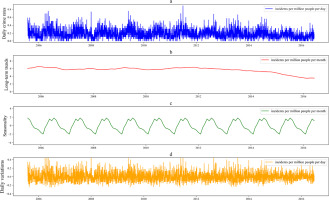Science of the Total Environment ( IF 8.2 ) Pub Date : 2020-03-25 , DOI: 10.1016/j.scitotenv.2020.138190 Bing Shen 1 , Xiaofeng Hu 1 , Huanggang Wu 2

|
Previous studies suggest that climate variability and change impact both violent and property crimes. To investigate the mechanism, time series of crime rates (crime incidents per million people) and climate variables (temperature, relative humidity, rainfall, wind speed and haze) are decomposed into three components– long-term trends, seasonality and daily variations (or “noise”). Based on a 12-year dataset of daily crime (robbery, minimal violent robbery (MVR), assault, rape and homicide) numbers in Beijing, China, the correlation between climate variability and crime rate is examined for each component. The results show that in terms of seasonality, strong positive relations are observed for temperature-to-MVR, temperature-to-assault, temperature-to-rape, and relative-humidity-to-MVR but negative relations for haze-to-MVR, haze-to-assault, and haze-to-rape, which can be explained by Routine Activity Theory. In terms of daily variations, temperature, rainfall and haze are key factors. The correlations are all positive for temperature-to-assault, temperature-to-rape, temperature-to-homicide, rainfall-to-MVR, rainfall-to-robbery and rainfall-to-homicide. However, the relations between haze and crimes are more complicated. Specifically, the correlations are negative for haze-to-MVR and haze-to-robbery, but positive for haze-to-homicide, which can be interpreted by Crime Pattern Theory and also influenced by offenders' bounded rationality.











































 京公网安备 11010802027423号
京公网安备 11010802027423号